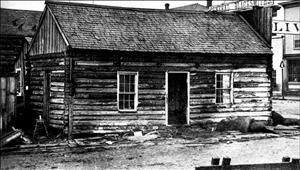On April 24, 1851, Alfred A. Plummer (1822-1883) and Charles Bachelder land on a beach at the mouth of Port Townsend, an extensive bay at the northeast corner of the Olympic Peninsula in what is now Jefferson County. They immediately file land claims and begin building a cabin. Plummer and Bachelder are the first non-Indians to settle in the area called Kah Tai by the Clallam Indians whose land it is. Six months later they join with two newer arrivals, Loren B. Hastings (1814-1881), and Francis W. Pettygrove (d. 1887) to establish the new town of Port Townsend, which they name for the bay.
In 1850, Alfred Plummer, a native of Maine, was running a hotel in San Francisco. Although he made money catering to the gold rush crowds, he wanted to find land to settle on. One of his hotel guests was Capt. Lafayette Balch, who commanded the brig George Emery, sailing between San Francisco and Puget Sound. Balch told Plummer about the opportunities available in the Puget Sound region, with its fertile soil, vast stands of timber, and excellent harbors. Plummer and his friend Charles Bachelder were convinced. In the spring of 1851, they sailed with Capt. Balch for Steilacoom, an early settlement located on the Sound in what is now Pierce County.
Landing on the Beach
As the George Emery passed Port Townsend harbor on its way into Puget Sound, Balch pointed out the bay and recommended its shore as a townsite. In Steilacoom, Plummer and Bachelder obtained an Indian canoe and paddled it back up the Sound to Port Townsend harbor. On April 24, 1851, they landed at what is now the city of Port Townsend waterfront, on a beach below Point Hudson, the sandy cape at the entrance to the bay.
Their landing spot was on the lands of the Clallam Indians, who inhabited a large portion of the northern Olympic Peninsula. For years, Point Hudson had been a seasonal gathering spot where the Clallams harvested abundant shellfish and seafood resources, and a stopping point for Indians of many groups as they traveled Puget Sound and the Strait of Juan de Fuca in their massive carved cedar canoes. Some way south along the beach was a village site. The village, or the area, was named Kah Tai or Ka-tal in the Clallam language, reportedly meaning "to carry" or "pass through," in reference to portaging canoes.
Plummer and Bachelder gave presents to the Clallam leaders in return for permission to settle on their lands. They also claimed the land according to American law, by staking claims under the Donation Land Claim Act. Plummer's claim was dated the very day they landed, April 24, 1851. The men built a two-room log cabin on the beach at what is now the corner of Water and Tyler streets. Behind the cabin Plummer planted a garden with seeds brought from San Francisco.
Patriarch of the Town
In October 1851, Plummer and Bachelder were visited by Loren Hastings and Francis Pettygrove, who were scouting Puget Sound for a location to re-settle their families, then living in Portland. The four men agreed to start a town, which they called Port Townsend, on the site. Hastings and Pettygrove returned the following year with their families and other settlers, and the town was platted and began to grow.
Charles Bachelder shortly sold his claim to Pettygrove and left the town he had been one of the first to settle. Plummer, who soon married, remained and, along with Hastings and Pettygrove, played a leading role in the new community. When James G. Swan (1818-1900), who would himself become one of Port Townsend's most accomplished and intriguing residents, arrived in the town in 1859, he wrote of Plummer (then 37 years old):
"Mr. Plummer is the patriarch of the town, although his hair is not yet frosted by age, yet from the fact that he was the first settler at Port Townsend, he claims the right of precedence, and is recognized by all as the 'elip tellicum,' or first man" (Swan, 12).

